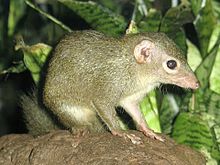Common treeshrew
| Common treeshrew | |
|---|---|
 |
|
| Scientific classification | |
| Kingdom: | Animalia |
| Phylum: | Chordata |
| Class: | Mammalia |
| Order: | Scandentia |
| Family: | Tupaiidae |
| Genus: | Tupaia |
| Species: | T. glis |
| Binomial name | |
|
Tupaia glis Diard & Duvaucel, 1820 |
|
 |
|
| Common treeshrew range | |
The common treeshrew (Tupaia glis) is a small mammal in the treeshrew family Tupaiidae, and is native to Thailand, Malaysia, and Indonesia. It has been listed as Least Concern by IUCN as it remains common and displays some adaptability to ongoing habitat loss.
The common treeshrew is one of the largest among treeshrews. Average body length is between 16 and 21 cm (6.3 and 8.3 in), and average weight is around 190 g, with varying colours of reddish-brown, greyish or black upper parts and whitish belly. Its long, bushy tail is dark greyish-brown and almost reaches the length of the body. The paws are bare with sharp nails, and with a naked patch of skin above its long nose. Both sexes are similar. The animal has a head and body length of 13–21 cm and a tail length of 12–20 cm. The common treeshrew usually has a white, pale stripe on each shoulder.
The two subspecies are T. g. longipes and T. g. salatana, with T. g. longipes being duller in color than T. g. salatana. The underparts of T. g. longipes are dull buff to reddish-buff, and the underside of the tail is greyish. The underparts and underside of the tail are dark reddish in T. g. salatana. Similar species are Tupaia splendidula and Tupaia montana.
Common treeshrews occur south of about 10°N latitude in southern Thailand through mainland Malaysia and adjacent coastal islands to Singapore. They inhabit protected areas, including the Pasoh Forest Reserve on the Malay Peninsula and Krau Wildlife Reserve. In Indonesia, they are found on the islands of Siberut, Batu, Sumatra, Java, Bangka, Riau, Lingga and Anambas. Usually they are found in primary dipterocarp forest, but are tolerant to some degree of habitat modification. They have also been recorded from secondary forest, plantations, fruit orchards, and trees near housing areas.
...
Wikipedia

